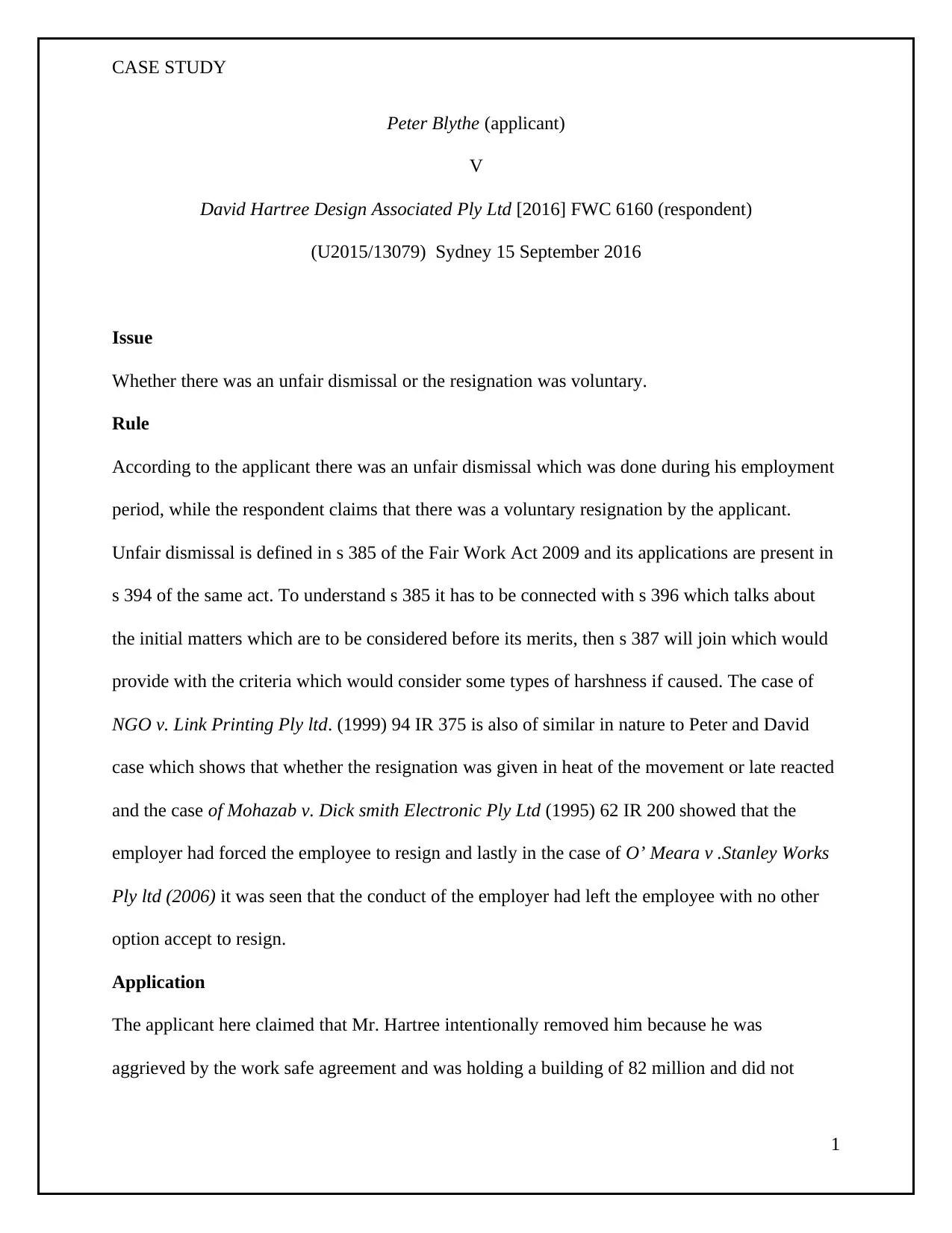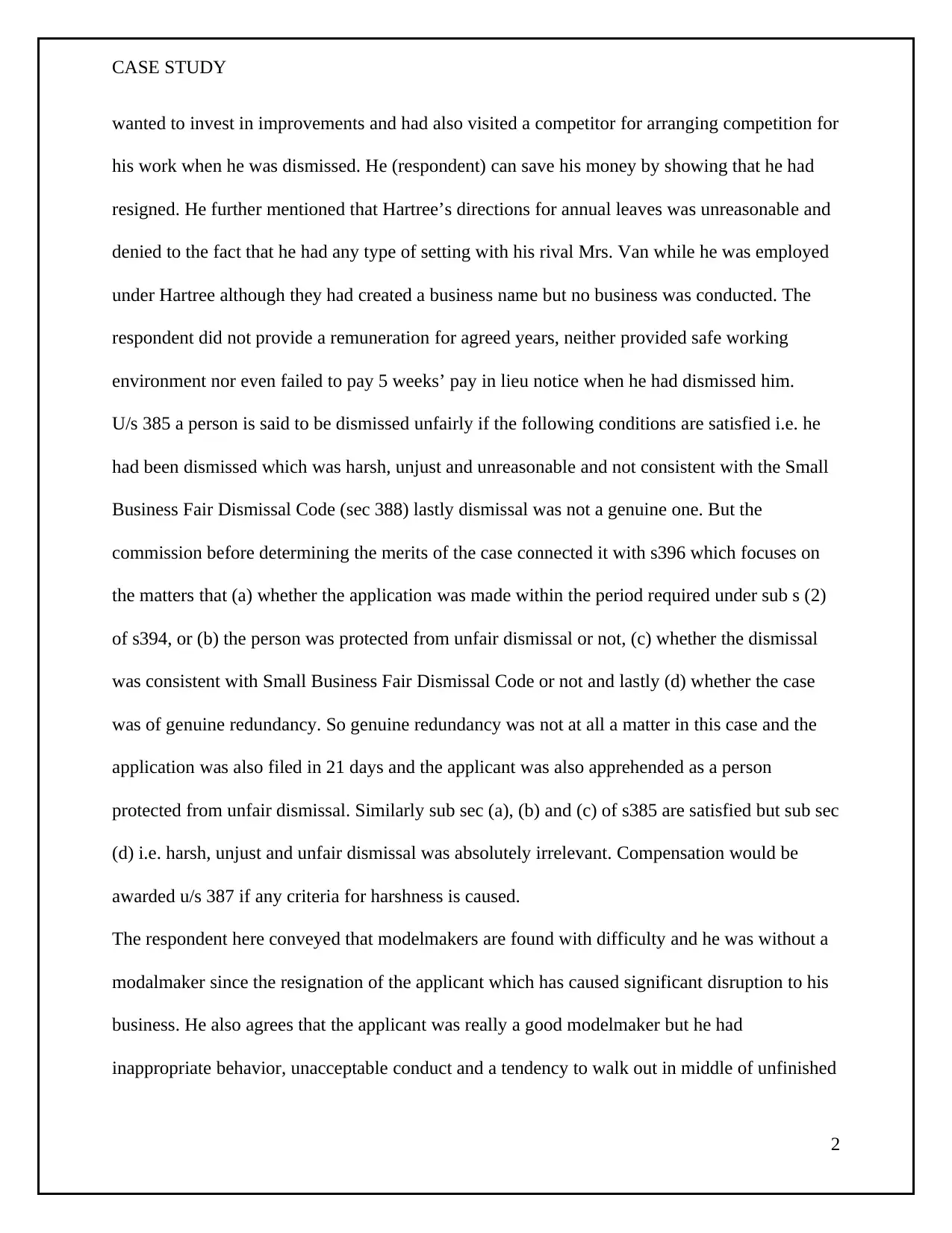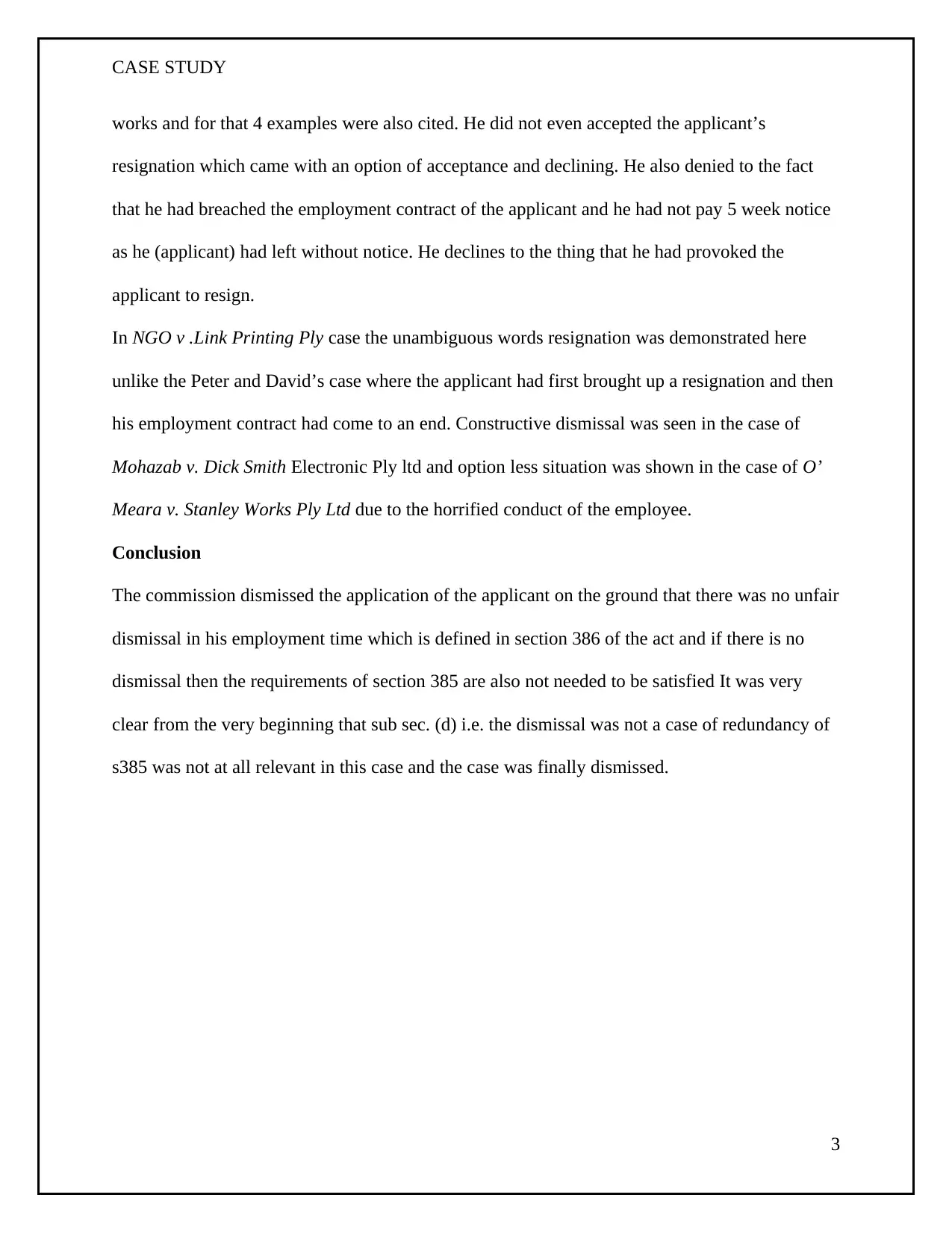Case Study: Peter Blythe vs. David Hartree Design Associates
VerifiedAdded on 2022/12/29
|4
|996
|73
Case Study
AI Summary
This case study analyzes the legal dispute between Peter Blythe and David Hartree Design Associates, focusing on the claim of unfair dismissal. The case revolves around whether Blythe was unfairly dismissed or if his departure was a voluntary resignation. The analysis examines the application of the Fair Work Act 2009, including sections 385, 394, 396, and 387, as well as relevant case law such as NGO v. Link Printing Pty Ltd, Mohazab v. Dick Smith Electronics Pty Ltd, and O’Meara v. Stanley Works Pty Ltd. The applicant alleged unfair dismissal due to disagreements over workplace safety and alleged actions by the respondent, while the respondent argued for voluntary resignation and cited Blythe's conduct. The commission ultimately dismissed the application, concluding that no unfair dismissal occurred, thus the requirements of section 385 were not met.

CASE STUDY
Peter Blythe (applicant)
V
David Hartree Design Associated Ply Ltd [2016] FWC 6160 (respondent)
(U2015/13079) Sydney 15 September 2016
Issue
Whether there was an unfair dismissal or the resignation was voluntary.
Rule
According to the applicant there was an unfair dismissal which was done during his employment
period, while the respondent claims that there was a voluntary resignation by the applicant.
Unfair dismissal is defined in s 385 of the Fair Work Act 2009 and its applications are present in
s 394 of the same act. To understand s 385 it has to be connected with s 396 which talks about
the initial matters which are to be considered before its merits, then s 387 will join which would
provide with the criteria which would consider some types of harshness if caused. The case of
NGO v. Link Printing Ply ltd. (1999) 94 IR 375 is also of similar in nature to Peter and David
case which shows that whether the resignation was given in heat of the movement or late reacted
and the case of Mohazab v. Dick smith Electronic Ply Ltd (1995) 62 IR 200 showed that the
employer had forced the employee to resign and lastly in the case of O’ Meara v .Stanley Works
Ply ltd (2006) it was seen that the conduct of the employer had left the employee with no other
option accept to resign.
Application
The applicant here claimed that Mr. Hartree intentionally removed him because he was
aggrieved by the work safe agreement and was holding a building of 82 million and did not
1
Peter Blythe (applicant)
V
David Hartree Design Associated Ply Ltd [2016] FWC 6160 (respondent)
(U2015/13079) Sydney 15 September 2016
Issue
Whether there was an unfair dismissal or the resignation was voluntary.
Rule
According to the applicant there was an unfair dismissal which was done during his employment
period, while the respondent claims that there was a voluntary resignation by the applicant.
Unfair dismissal is defined in s 385 of the Fair Work Act 2009 and its applications are present in
s 394 of the same act. To understand s 385 it has to be connected with s 396 which talks about
the initial matters which are to be considered before its merits, then s 387 will join which would
provide with the criteria which would consider some types of harshness if caused. The case of
NGO v. Link Printing Ply ltd. (1999) 94 IR 375 is also of similar in nature to Peter and David
case which shows that whether the resignation was given in heat of the movement or late reacted
and the case of Mohazab v. Dick smith Electronic Ply Ltd (1995) 62 IR 200 showed that the
employer had forced the employee to resign and lastly in the case of O’ Meara v .Stanley Works
Ply ltd (2006) it was seen that the conduct of the employer had left the employee with no other
option accept to resign.
Application
The applicant here claimed that Mr. Hartree intentionally removed him because he was
aggrieved by the work safe agreement and was holding a building of 82 million and did not
1
Paraphrase This Document
Need a fresh take? Get an instant paraphrase of this document with our AI Paraphraser

CASE STUDY
wanted to invest in improvements and had also visited a competitor for arranging competition for
his work when he was dismissed. He (respondent) can save his money by showing that he had
resigned. He further mentioned that Hartree’s directions for annual leaves was unreasonable and
denied to the fact that he had any type of setting with his rival Mrs. Van while he was employed
under Hartree although they had created a business name but no business was conducted. The
respondent did not provide a remuneration for agreed years, neither provided safe working
environment nor even failed to pay 5 weeks’ pay in lieu notice when he had dismissed him.
U/s 385 a person is said to be dismissed unfairly if the following conditions are satisfied i.e. he
had been dismissed which was harsh, unjust and unreasonable and not consistent with the Small
Business Fair Dismissal Code (sec 388) lastly dismissal was not a genuine one. But the
commission before determining the merits of the case connected it with s396 which focuses on
the matters that (a) whether the application was made within the period required under sub s (2)
of s394, or (b) the person was protected from unfair dismissal or not, (c) whether the dismissal
was consistent with Small Business Fair Dismissal Code or not and lastly (d) whether the case
was of genuine redundancy. So genuine redundancy was not at all a matter in this case and the
application was also filed in 21 days and the applicant was also apprehended as a person
protected from unfair dismissal. Similarly sub sec (a), (b) and (c) of s385 are satisfied but sub sec
(d) i.e. harsh, unjust and unfair dismissal was absolutely irrelevant. Compensation would be
awarded u/s 387 if any criteria for harshness is caused.
The respondent here conveyed that modelmakers are found with difficulty and he was without a
modalmaker since the resignation of the applicant which has caused significant disruption to his
business. He also agrees that the applicant was really a good modelmaker but he had
inappropriate behavior, unacceptable conduct and a tendency to walk out in middle of unfinished
2
wanted to invest in improvements and had also visited a competitor for arranging competition for
his work when he was dismissed. He (respondent) can save his money by showing that he had
resigned. He further mentioned that Hartree’s directions for annual leaves was unreasonable and
denied to the fact that he had any type of setting with his rival Mrs. Van while he was employed
under Hartree although they had created a business name but no business was conducted. The
respondent did not provide a remuneration for agreed years, neither provided safe working
environment nor even failed to pay 5 weeks’ pay in lieu notice when he had dismissed him.
U/s 385 a person is said to be dismissed unfairly if the following conditions are satisfied i.e. he
had been dismissed which was harsh, unjust and unreasonable and not consistent with the Small
Business Fair Dismissal Code (sec 388) lastly dismissal was not a genuine one. But the
commission before determining the merits of the case connected it with s396 which focuses on
the matters that (a) whether the application was made within the period required under sub s (2)
of s394, or (b) the person was protected from unfair dismissal or not, (c) whether the dismissal
was consistent with Small Business Fair Dismissal Code or not and lastly (d) whether the case
was of genuine redundancy. So genuine redundancy was not at all a matter in this case and the
application was also filed in 21 days and the applicant was also apprehended as a person
protected from unfair dismissal. Similarly sub sec (a), (b) and (c) of s385 are satisfied but sub sec
(d) i.e. harsh, unjust and unfair dismissal was absolutely irrelevant. Compensation would be
awarded u/s 387 if any criteria for harshness is caused.
The respondent here conveyed that modelmakers are found with difficulty and he was without a
modalmaker since the resignation of the applicant which has caused significant disruption to his
business. He also agrees that the applicant was really a good modelmaker but he had
inappropriate behavior, unacceptable conduct and a tendency to walk out in middle of unfinished
2

CASE STUDY
works and for that 4 examples were also cited. He did not even accepted the applicant’s
resignation which came with an option of acceptance and declining. He also denied to the fact
that he had breached the employment contract of the applicant and he had not pay 5 week notice
as he (applicant) had left without notice. He declines to the thing that he had provoked the
applicant to resign.
In NGO v .Link Printing Ply case the unambiguous words resignation was demonstrated here
unlike the Peter and David’s case where the applicant had first brought up a resignation and then
his employment contract had come to an end. Constructive dismissal was seen in the case of
Mohazab v. Dick Smith Electronic Ply ltd and option less situation was shown in the case of O’
Meara v. Stanley Works Ply Ltd due to the horrified conduct of the employee.
Conclusion
The commission dismissed the application of the applicant on the ground that there was no unfair
dismissal in his employment time which is defined in section 386 of the act and if there is no
dismissal then the requirements of section 385 are also not needed to be satisfied It was very
clear from the very beginning that sub sec. (d) i.e. the dismissal was not a case of redundancy of
s385 was not at all relevant in this case and the case was finally dismissed.
3
works and for that 4 examples were also cited. He did not even accepted the applicant’s
resignation which came with an option of acceptance and declining. He also denied to the fact
that he had breached the employment contract of the applicant and he had not pay 5 week notice
as he (applicant) had left without notice. He declines to the thing that he had provoked the
applicant to resign.
In NGO v .Link Printing Ply case the unambiguous words resignation was demonstrated here
unlike the Peter and David’s case where the applicant had first brought up a resignation and then
his employment contract had come to an end. Constructive dismissal was seen in the case of
Mohazab v. Dick Smith Electronic Ply ltd and option less situation was shown in the case of O’
Meara v. Stanley Works Ply Ltd due to the horrified conduct of the employee.
Conclusion
The commission dismissed the application of the applicant on the ground that there was no unfair
dismissal in his employment time which is defined in section 386 of the act and if there is no
dismissal then the requirements of section 385 are also not needed to be satisfied It was very
clear from the very beginning that sub sec. (d) i.e. the dismissal was not a case of redundancy of
s385 was not at all relevant in this case and the case was finally dismissed.
3
⊘ This is a preview!⊘
Do you want full access?
Subscribe today to unlock all pages.

Trusted by 1+ million students worldwide

CASE STUDY
Reference
Peter Blythe v. David Hartree Design Associates Ply Ltd (2016) U2015/13079
NGO v. Link Printing Ply ltd. (1999) 94 IR 375
Mohazab v. Dick smith Electronic Ply Ltd (1995) 62 IR 200
O’ Meara v .Stanley Works Ply ltd (2006)
The Fair Work Act 2009
4
Reference
Peter Blythe v. David Hartree Design Associates Ply Ltd (2016) U2015/13079
NGO v. Link Printing Ply ltd. (1999) 94 IR 375
Mohazab v. Dick smith Electronic Ply Ltd (1995) 62 IR 200
O’ Meara v .Stanley Works Ply ltd (2006)
The Fair Work Act 2009
4
1 out of 4
Related Documents
Your All-in-One AI-Powered Toolkit for Academic Success.
+13062052269
info@desklib.com
Available 24*7 on WhatsApp / Email
![[object Object]](/_next/static/media/star-bottom.7253800d.svg)
Unlock your academic potential
Copyright © 2020–2025 A2Z Services. All Rights Reserved. Developed and managed by ZUCOL.





